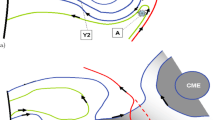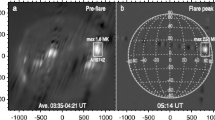Abstract
For almost 30 hr after the major (gamma-ray) two-ribbon flare on 6 November 1980, 03:30 UT, the Hard X-Ray Imaging Spectrometer (HXIS) aboard the SMM satellite imaged in > 3.5 keV X-rays a gigantic arch extending above the active region over the limb. Like a similar configuration on 22 May 1980, this arch formed the lowest part of a stationary post-flare radio noise storm recorded at metric wavelengths at Nançay and Culgoora. 6.5 hr after the flare a coronal region below the arch started quasi-periodic pulsations in X-ray brightness, observed by several SMM instruments. These brightness variations had no response in the chromosphere (Hα), very little in the transition layer (O v), but they clearly correlated with similar variations in brightness at 169 MHz. There were 13 pulses of this kind, with apparent periodicity of about 20 min, until another flare occurred in the active region at ∼ 15:00 UT. All the brightenings appeared within a localized area of about 30000 km2 in the northern part of the active region, but they definitely did not occur all at the same place.
The top of the X-ray arch, at an altitude of ∼ 155 000 km, was continuously and smoothly decaying, taking no part in the striking variations below it. Therefore, the area variable in brightness does not seem to be the footpoint of the arch, as we supposed for similar variations on 22 May. More likely, it is a separate region connected directly with the source of the radio storm; particles accelerated in the storm may be dumped into the low corona and cause the X-ray enhancements. The X-ray arch was enhanced by two orders of magnitude in 3.5–5.5 keV X-ray counts and the temperature increased from ≲ 7.3 × 106 to 9 × 106 K when the new two-ribbon flare occurred at 15:00 UT. Thus, it is possible that energy is brought into the arch via the upper parts of the reconnecting flare loops - a process that can continue for hours.
Similar content being viewed by others
References
Acton, L. W., Culhane, J. L., Gabriel, A. H., and 21 co-authors: 1980, Solar Phys. 65, 53.
Anzer, U. and Pneuman, G. W.: 1982, Solar Phys. 79, 129.
Lantos, P., Kerdraon, A., Rapley, C. G., and Bentley, R. D.: 1981, Astron. Astrophys. 101, 33.
Orwig, L. E., Frost, K. J., and Dennis, B. R.: 1980, Solar Phys. 65, 25.
Ryan, J. M., Chupp, E. L., Forrest, D. J., Reppin, C., Reiger, E., Kambach, G., Pinkau, K., Shore, G., and Krieger, R. L.: 1980, Bull. Am. Astron. Soc. 12, 891.
Švestka, Z., Stewart, R. T., Hoyng, P., Van Tend, W., Acton, L. W., Gabriel, A. H., Rapley, C. G., and 8 co-authors: 1982, Solar Phys. 75, 305.
Švestka, Z., Schrijver, J., Somov, B., Dennis, B. R., Woodgate, B. E., Fürst, E., Hirth, W., Klein, L., and Raoult, A.: 1983, to be submitted to Solar Phys.
Van Beek, H. F., Hoyng, P., Lafleur, H., and Simnett, G. M.: 1980, Solar Phys. 65, 39
Woodgate, B. E., Tandberg-Hanssen, E. A., Bruner, E. C., and 11 co-authors: 1980, Solar Phys. 65, 73.
Author information
Authors and Affiliations
Rights and permissions
About this article
Cite this article
Švestka, Z., Dennis, B.R., Pick, M. et al. Unusual coronal activity following the flare of 6 November 1980. Sol Phys 80, 143–159 (1982). https://doi.org/10.1007/BF00153429
Received:
Issue Date:
DOI: https://doi.org/10.1007/BF00153429




